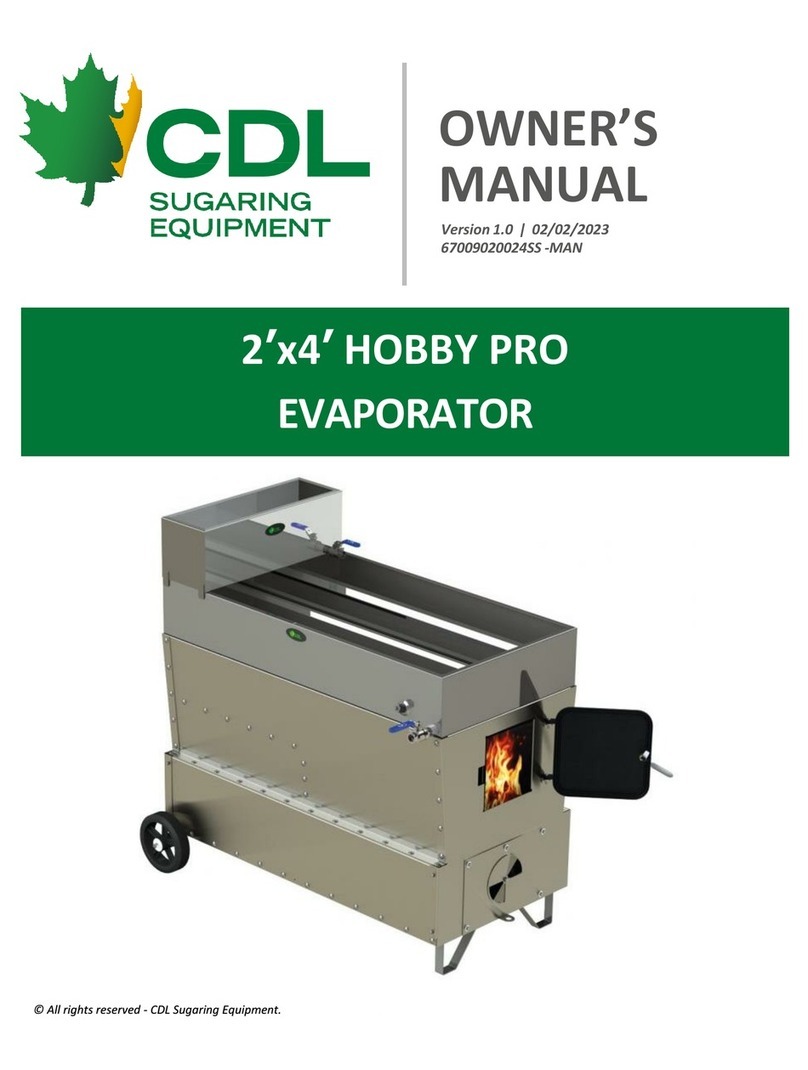
9
CDL Maple Sugaring Equipment inc.
Operation during the boiling process
1. Using defoamer is necessary to the good operation of the evaporator. When the syrup
generates too much foam, the float boxes will have difficulty maintaining a proper level in
the pans and you might run the pans dry. RUNNING THE EVAPORATOR WITH NOT ENOUGH
LIQUID IN THE PANS COULD RESULT IN PERMANENT DAMAGE TO THE EQUIPMENT. Also,
the defoamer helps avoiding the foam from overflowing above the pan walls, preventing a
huge mess.
2. ALWAYS pay attention to the liquid level in all the pans. Adjust the floats in necessary.
3. Maple syrup is ready when the temperature hits 7 degrees above the boiling point of water.
Open the draw-off valve when the syrup reaches this level and close it when the temperature
comes back below this value. An automatic draw-off valve is a very useful option to improve
consistency of the maple syrup. Don’t add wood if the syrup is almost ready. The temperature
under the syrup pans will become too high and you might burn your syrup. Wait after you
draw-off.
4. Repeat drawing-off syrup every time the temperature gets to 7 degrees above the boiling
point. It’s possible that the draw-off temperature may vary over time. This is caused by
variations in the atmospheric pressure. Verify regularly your syrup using hydrometer, a
densimeter or a refractometer to make sure you have the right sugar content.
5. As your confidence level increases, you can lower the liquid level in the pans. The ideal level
in the flue pan is 1” above the flues and 1½” to 2” in the syrup pans. Lower the levels in the
pans boils faster and helps making lighter syrup. Don’t go lower than those levels. Going
too low increases the risk of burning the pans.
6. After each day of boiling, it is recommended to drain the sap in both float boxes.
7. When you are almost done for the day, make sure you have enough sap left in your tank to fill
all the pans 2” higher than the normal sap level. It will compensate for the evaporation that
will keep on happening because of the heat accumulated in the evaporator until it cools down.
If you have any questions, don’t hesitate to contact your CDL sales representative.
IMPORTANT SAFETY NOTE:
THE HEAT IN FRONT OF THE EVAPORATOR WHEN THE DOOR IS OPEN IS INTENSE. ALWAYS
WEAR GLOVES, SAFETY GLASSES AND HEAT RESISTANT CLOTHING WHEN FIRING THE
EVAPORATOR.




























